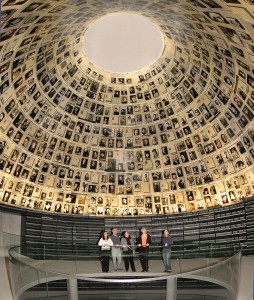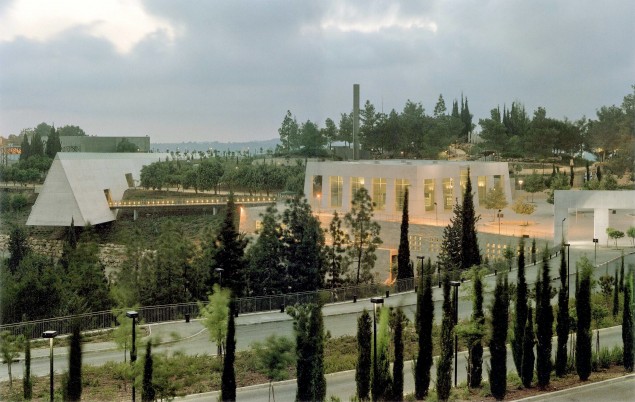On and Off the Beaten Track in . . . Yad Vashem
Israel’s National Holocaust Memorial
I am writing this article while seated on a train in Poland, traveling between Warsaw and Krakow. Watching the Polish countryside zip by from my comfortable first-class seat, my mind keeps drifting back to the millions of Jews who rode on these same tracks over seventy years ago, crammed into cattle cars on their way to imminent death in the gas chambers of Auschwitz-Birkenau.
I decided to devote this column to writing about the Yad Vashem Museum while on this trip through Poland, where more than three million Jews lived prior to World War II; ninety percent of the prewar Jewish community perished at the hands of the Nazis. (Among them were my relatives who lived in Warsaw and Lomza.)
In the twenty-some years I have been privileged to be a tour guide in Israel, I have frequently given tours of Yad Vashem. But there is no question that after this trip, my tours of the museum will never quite be the same. I understand now in a much more profound way why visiting Yad Vashem is imperative for both Jews visiting Israel as well as for those who live here. It is a place one should visit and revisit. The museum’s messages are as pertinent today as they were when Yad Vashem was one of the first national institutions created by the fledgling State of Israel in the early 1950s, and we dare not live our lives without a constant awareness of their ongoing relevance.

The museum, designed to personalize the experience of the Holocaust, features a central walkway with exhibition galleries on each side.
The new Holocaust History Museum at Yad Vashem opened in 2005. At the main entrance to the exhibit hall, one first encounters documentary footage depicting prewar Jewish life in Eastern Europe, when the possibility of a Holocaust was inconceivable. The opening film manages to capture the richness of Jewish life—religious and cultural, a mosaic of the breadth of Judaism in prewar Europe. One of the most meaningful scenes shows the children of a Religious Zionist youth organization singing “Hatikvah” in the 1930s in Munkatch, Hungary.
The museum, designed to personalize the experience of the Holocaust, features a central walkway with exhibition galleries on each side. The walkway design creates, as the Yad Vashem web site describes it, “a visitor’s route dictated by the evolving narrative, with a beginning, middle and end.” Visitors are “forced” to view the galleries in order, reminiscent of victims who had no choice but to experience the nightmare of the Holocaust as it happened. Each gallery aims to personify the experience through diaries, photographs, artifacts and testimonies. The images at the beginning of the walkway—life before the horror of the Holocaust descended upon European Jewry—are always visible, although they fade farther and farther away as the visitor proceeds chronologically from the 1930s into the 1940s. Soon they become part of the past, always there in the background but so far from the new reality of ghettos, starvation, disease, transports and death camps.
Before entering the memorial museum, I frequently ask my groups: “At what point in time should a museum begin the Holocaust story?” Some of the visitors say with images of life in Europe prior to the war; some suggest 1933, the year that Hitler rose to power. Others propose the year 1939, when Hitler invaded Poland, launching World War II and bringing over three million Jews into the clutches of the Nazis. Yad Vashem chose to remind us in the first exhibit hall that anti-Semitism is not a twentieth-century phenomenon but has accompanied us throughout history, often driven by church doctrine.
Yad Vashem also challenges us to confront critical issues: How do ordinary “good” people suddenly transform into monsters who can participate in the systematic dehumanization, marginalization and murder of fellow human beings? What was it like for the Jews of Germany in the 1930s after the Nuremberg Laws officialized anti-Semitism as the policy of Nazi Germany? Why didn’t they leave? Where would they go? One particularly poignant display highlights the tragic story of the St. Louis, a boat that set sail for Cuba in 1939 with 938 Jews on board, who subsequently discovered that their entry visas had been rescinded. The boat then sailed the 90 miles to the Florida coast where the United States summarily refused them entry as refugees. Eventually, not finding a port to disembark, the boat returned to Europe, where many of the passengers who had looked at freedom just over the rails perished at the hands of the Nazis.
On the museum wall, there is a quote from the Australian ambassador at the Evian Conference, held in 1938 to determine the plight of the Jewish refugees, which reads, “Australia does not have a racial problem, and we have no desire of importing one now.”
The next gallery, on the opposite side of the central corridor, depicts the Nazi invasion of Poland on September 1, 1939, and the overnight shift in the fate of Polish Jewry. Photos depict the public humiliation of Jews as smiling Nazi soldiers look on and the various discriminatory practices against Jews, including the wearing of Magen David armbands, the confiscation of Jewish property and the preparations to force Jews into ghettos. Cross the corridor once again and we experience the horror of deportations to ghettos and the appalling situations that confronted the victims once there. In Warsaw, approximately 400,000 Jews, including my great-aunt and her family, were forced into an area of 1.3 square miles. Disease, starvation and death became daily occurrences.

The Hall of Names at Yad Vashem is a memorial to each and every Jew who perished in the Holocaust—a place where the six million may be commemorated for generations to come. The main circular hall houses the extensive collection of “Pages of Testimony”—short biographies of each Holocaust victim.
I have always been particularly moved by an exhibit in the museum that tells the story of the Lodz Ghetto where the head of the Judenrat, Mordechai Chaim Rumkowski, was compelled by the Nazis to give up the children and elderly for deportation in order to save the remaining Jews in the ghetto.
For me, the most powerful element in the museum is the personal testimony: some one hundred video screens show survivor testimonies and short films.
I once heard a guide explain, correctly I believe, that the Holocaust is not about six million Jews who were murdered by the Nazis. It is about one story, told six million times in six million different ways. The museum is about giving back names and identities to those who were reduced to striped uniforms and numbers. These personal testimonies reveal not only enormous suffering but also stories of “righteous gentiles” who, risking their own lives, sheltered Jews and shared their limited rations with them.
The galleries take us through a continuing succession of events: the invasion of Russia in June 1941 in which Nazi troops were accompanied by killing units, whose job was to round up Jews and kill them; the Wannsee Conference where leaders of the Reich determined that gas chambers were the best and most efficient way to kill mass numbers of Jews; the deportations to the death camps; and finally, the liberation. Throughout, we are accompanied by the heartrending stories of those who actually witnessed the events being depicted.
There are Holocaust museums in the US and around the world. Most conclude the story of the Holocaust with the liberation. The final gallery at Yad Vashem is unique. It tells of the survivors’ efforts to find their way to Eretz Yisrael, often aided by the Haganah who packed ships such as the Exodus with refugees and attempted to smuggle them past British blockades and bring them home. What the British referred to as “illegal immigration” was called “clandestine immigration” by Jews, because there cannot be anything illegal about a Jew seeking to live in the Land of Israel. And then, before emerging for the last time in the central corridor, we hear the strains of “Hatikvah.” The video clips are the same ones we saw at the beginning—the youth in Munkatch singing of the eternal dream of the Jewish people to be a free people in “Eretz Avoteinu,” the Land of our Forefathers (today the text is slightly different—to be a free people “beartzeinu,” in our land), echoing a 2,000-year-old dream.
The final documentary footage, the last image after our brief visit back in time to the cataclysmic years of 1939 to 1944, is of David Ben-Gurion, standing at Independence Hall on May 14 (5 Iyar), 1948 and reciting for the world to hear:
“Accordingly we, members of the People’s Council, representatives of the Jewish community of Eretz-Israel and the Zionist Movement, are here assembled on the day of the termination of the British Mandate over Eretz-Israel and, by virtue of our natural and historic right and on the strength of the Resolution of the United Nations General Assembly, hereby declare the establishment of a Jewish state in Eretz-Israel to be known as the State of Israel” (www.knesset.gov.il /docs/eng/megilat_eng.htm).
Yad Vashem ends where modern Israel begins. It contains messages that must be repeated frequently, lest we fail to retain our feelings of gratitude for the gift of modern Israel and our sense of responsibility to preserve the memories of those who perished at the hands of the Nazis.
Peter Abelow is a licensed tour guide and the associate director of Keshet: The Center for Educational Tourism in Israel. Keshet specializes in creating and running inspiring family and group tours that make Israel come alive “Jewishly.”

